Two different versions of the comic-book hero Captain Marvel (one who recently acquired the name, and one who recently lost it) are heading to the big screen in the next few months – Marvel’s Captain Marvel in March:
and DC’s Shazam! in April:
I thought I’d give a brief history of the Captain Marvel concept here, both because it’s inherently somewhat interesting and because it illustrates the way in which intellectual property law doesn’t merely “protect” creative works but deeply shapes their content, like a traffic cop bouncing into the driver’s seat and deciding what destination you should head to.
The original Captain Marvel was created for Fawcett Publications in 1939 by writer Bill Parker and artist C. C. Beck – though circulation director Roscoe Fawcett claimed the core idea was his, reporting his initial charge to his writers as “Give me a Superman, only have his other identity be a 10 or 12-year-old boy.”
As the story unfolds, young orphan Billy Batson is chosen by the ancient wizard Shazam to become the superhero in question whenever he utters the wizard’s name, which is explained as an anagram of the various mythological and legendary figures from whom the transformed Billy derives his attributes: Solomon (wisdom), Hercules (strength), Atlas (stamina), Zeus (power), Achilles (courage), and Mercury (speed).
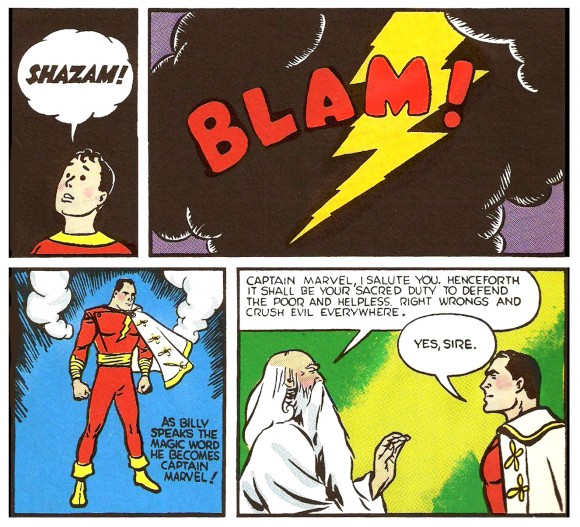
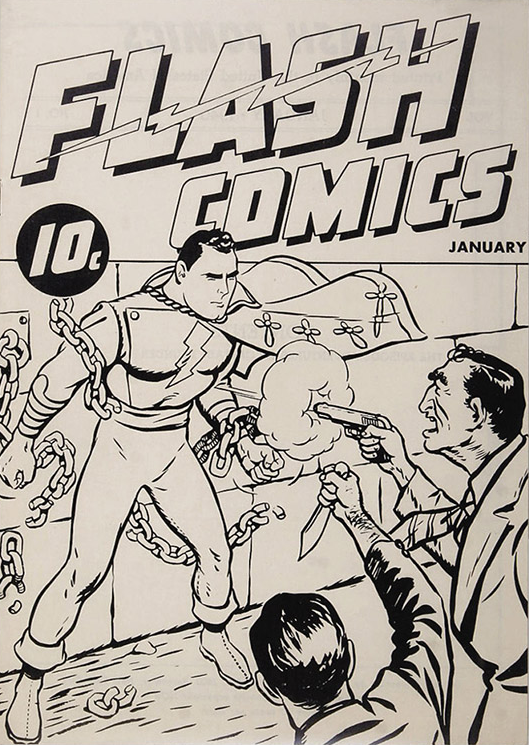
But this hero was originally named not Captain Marvel but Captain Thunder, and first saw the light(ning) of day in a black-and-white comic book cover-dated January 1940, and variously titled Thrill Comics and Flash Comics. These were “ashcan” editions, that is, hastily-assembled copies rushed into print solely in order to beat other publishers to the IP rights to the names involved. Thus the hero’s very first appearance was a response to IP law.

In their mission to secure the relevant IP rights, these first issues failed; it transpired that the names “Captain Thunder,” Thrill Comics (well, Thrilling Comics, anyway), and Flash Comics had already been nabbed. (The version of Flash Comics, likewise premiering with a cover date of January 1940, that had just barely taken precedence over Fawcett’s featured the debut of the well-known speedster superhero the Flash, first of his name.) So the folks at Fawcett headed back to the drawing board – ensuring that their hero’s second appearance would likewise be a response to IP law.
This is when Captain Thunder became Captain Marvel. His origin story, slightly rewritten, and now in full colour, appeared in the newly titled Whiz Comics – specifically in Whiz Comics #2, cover-dated February 1940. (The existence of a Whiz Comics #2 when there was never properly a Whiz Comics #1 would be an ongoing source of confusion to those unfamiliar with the ashcan venture – a confusion compounded by the fact that Fawcett later decided to renumber the issues in such a way that there would be two distinct issues #3.)
The name Whiz Comics was a nod to an earlier Fawcett publication, the racy humour magazine Captain Billy’s Whiz Bang. “Captain Billy” was Captain Wilford Fawcett, founder of Fawcett Publications, and a “whiz bang” was the name of a kind of artillery shell. (Compare today’s term “flash-bang” for a kind of grenade; evidently “whiz” and ”flash” remain quasi-substitutions for each other. Appropriately, an early imitation of the Flash was also named the Whizzer.) The earlier magazine is best remembered today as the subject of a passing line in The Music Man: “Is there a nicotine stain on his index finger? A dime novel hidden in the corn crib? Is he starting to memorize jokes from Captain Billy’s Whiz Bang?”
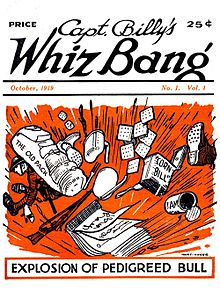
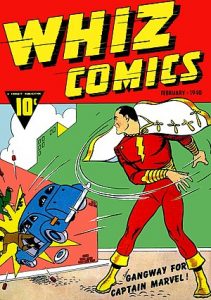
The new publication also echoed its predecessor in that it featured a protagonist named Billy who could turn into a Captain with a bang of magic lightning.
But what does it mean for a child to “turn into” an adult? On one understanding, it means that we end up with a child’s mind in an adult body – a super-powered analogue of Tom Hanks’ character in Big. This is the interpretation that has prevailed in recent interpretations of the Captain Marvel character, and judging from the trailers it’s the take that the forthcoming Shazam! movie will be going with as well.
A different interpretation, one explored in such extracanonical works as Frank Miller’s Dark Knight Strikes Again, has Billy Batson and Captain Marvel (henceforth BB and CM) being two distinct people, with one replacing the other when the lightning strikes.
But it’s pretty clear that neither was the original intention. After all, when BB transforms into CM he acquires the wisdom of Solomon and the courage of Achilles; in other words, BB and CM were not originally supposed to be psychologically interchangeable.
This tension between the hero’s canonical origin and his current characterisation was lampshaded on the Young Justice tv show; when the members of the Justice League are debating whether CM’s secret identity as the ten-year-old BB should make him ineligible for membership, Red Tornado points out that CM possesses the wisdom of Solomon, to which Aquaman replies: “Wisdom does not equal maturity.”
But … um … doesn’t wisdom imply maturity, more or less? That seems to have been the original conception: CM, in his early appearances, was presented as having (or so it seems to this reader) a more adult mentality than his BB counterpart. All the same, CM was also clearly presented as someone BB genuinely turned into, not someone who replaced BB. The suggestion was usually that the two were psychologically and subjectively continuous, but that the transformation from one to the other was nevertheless mental and not only physical.

The original conception led in some odd directions. For example, in one 1941 story, young BB is bored one evening, wonders whether CM’s sometime girlfriend Beautia is free, and so transforms into a (now tuxedo-clad) CM to pay her a visit. This raises more questions than it answers.
CM was soon joined in superherodom by BB’s sister Mary Batson and friend Freddy Freeman, as Mary Marvel and Captain Marvel Jr. respectively. (Unlike CM, they, for reasons never explained, did not appear any older in their transformed versions. Freeman is unusual among Golden Age heroes in being both physically disabled [explicitly] and Jewish [by implication].)

These teenaged heroes acquire as archenemies the villainous daughter and son, again respectively, of CM’s own arch-nemesis, the evil scientist Dr. Sivana. (Modern readers tend to think of Black Adam, CM’s predecessor who fell to the dark side, as CM’s primary nemesis; but in fact he was originally a one-off, appearing in only one issue, in 1945, during the original Fawcett run.)
One fan of the CM franchise was, reportedly, Elvis Presley, who is said to have based his hairstyle, lightning bolt motif, and penchant for white capes on CM and/or CM Jr. I merely transmit, I do not assert.
For a time, CM was more popular than Superman, even spawning his own live-action movie serial (1941) seven years before his Kryptonian rival followed suit. But DC (then National) Comics, the publisher of the Superman books, took the line that CM was too similar to the earlier character (Superman debuted in 1938), and brought legal action against Fawcett. After a series of legal battles, Fawcett finally lost in court in 1951, and ceased publication of all its CM-related titles by 1953. Hence CM died as he was (twice) born, as a response to IP law.
Incidentally, another DC character who might have raised IP problems for CM, but apparently didn’t, was Johnny Thunder, who premiered in the very same inaugural January 1940 issue of Flash Comics that pre-empted Fawcett’s ashcan version of Flash Comics from the same month. Johnny Thunder was a young man who summons a magic lightning bolt by (initially accidentally) uttering a magic word – though the lightning bolt is a genie who helps him, rather than a force that transforms him. (I suspect this character may have been influenced in turn by L. Frank Baum’s novel The Master Key, about a boy who accidentally stumbles on a pattern of electrical wiring that summons a Demon of Electricity who is likewise basically a wish-granting genie.)
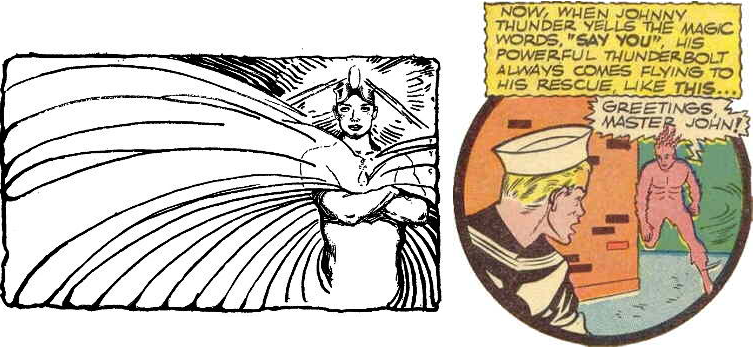
In any case, superheroes have a hard time staying entirely dead. Len Miller & Son, a British publisher, had been reprinting CM stories in black and white for the u.k. market; when Fawcett’s CM line was forced to fold, Miller hired writer-artist Mick Anglo (whose name seems to mean “Irishman-Englishman”) to create a replacement. Thus debuted Marvelman, who was, it’s fair to say, a rather close copy of CM.
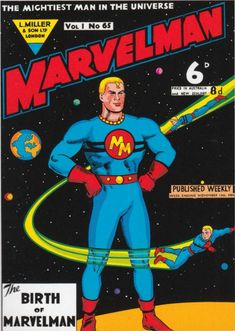
To be sure, Marvelman’s origin was made “scientific” rather than magical; but all this meant in practice was that instead of uttering the magic word “Shazam,” young Micky Moran (yes, Anglo named his BB counterpart after himself) transformed into Marvelman by uttering the scientific word “Kimota” (“Atomik” backwards – because, y’know, science).
Billed somewhat more ambitiously as the “Mightiest Man in the Universe” rather than merely the “World’s Mightiest Mortal,” the British Marvelman embarked on a series of familiarly CM-like adventures, battling an archenemy, Dr. Gargunza, who was a dead ringer for Dr. Sivana, except with a full head of hair in lieu of Sivana’s bald pate. Marvelman’s sidekicks, Young Marvelman and Kid Marvelman, were likewise essentially similar to CM’s sidekicks, apart from both being male; and they too found archnemeses in the form of Gargunza’s nephew (imaginatively named Young Gargunza) and his extraterrestrial sometime-ally Young Nastyman (sigh). This initial run of Marvelman comics lasted through 1963, apparently facing no challenges from either DC or Fawcett during its nine-year course of existence.
Back on this side of the Atlantic, Marvel Comics debuted the Mighty Thor, a character from Norse mythology (obviously), but with what is likely a CM-inspired twist: in Stan Lee and Jack Kirby’s original version, disabled physician Don Blake gains the power to transform into Thor in a burst of lightning. There’s even an initial ambiguity as to whether Blake merely gains the power of Thor, or is actually replaced by Thor.


By 1967, Marvel Comics had acquired the rights to the title (but not the original character) “Captain Marvel.” Legally, Marvel would retain the trademark so long as they published a Captain Marvel comic at least every two years – which is part of the reason why, since the new character’s death in 1982 (a rare case of a dead superhero who has mostly stayed dead since), Marvel has temporarily bestowed the title “Captain Marvel” on one character after another.
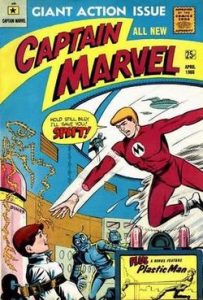
(Incidentally, a completely different “Captain Marvel,” an android who threw his own severed limbs at people [a forerunner of DC’s Arm-Fall-Off Boy?], had featured a year earlier in a handful of issues from the short-lived M. F. Enterprises.)
The new 1967 CM, created by Stan Lee, initially had little in common with his Fawcett predecessor; he was an alien named Mar-Vell, a member of the hostile Kree race that had been introduced earlier the same year in the pages of Fantastic Four; he had no superpowers; and his costume was a green-and-white Kree military uniform that bore no resemblance to CM’s traditional threads.
Over time, however, the gap between the new Captain and the old began to narrow. Mar-Vell switched from the role of invader to protector ; he went through a series of cosmic encounters, each one leaving him with a bigger power upgrade; and he ditched his Kree uniform for a mostly-red costume with golden wristbands and a golden starburst on the chest, an obvious echo of the original CM’s duds. His supporting cast even included a character named Dr. Savannah, a nod to Dr. Sivana.
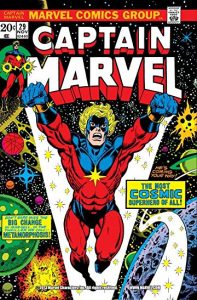
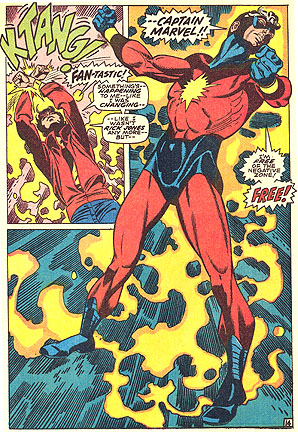
In the clearest parallel of all, Mar-Vell became bonded to teenager Rick Jones (originally a sidekick first of the Hulk and later of Captain America); touching the wristbands together would cause Mar-Vell and Jones to switch places, with one being able to act on Earth while the other had to cool his heels in another dimension.
Incidentally, the first Marvel comic I ever bought was Captain Marvel #32, in 1974; it featured Mar-Vell teaming up with a number of other heroes (including Iron Man and a green-skinned alien named Drax) to combat a purple-skinned, death-obsessed alien named Thanos who had just used an ancient cosmic artifact to give himself godlike powers. (And I bought it because of the resemblance of its cover to that of the first DC comic I’d ever bought, just the year before; see if you can spot the similarity.)

While it’s well-known that the recent movie Avengers: Infinity War was heavily based on Jim Starlin’s 1991 comic series Infinity Gauntlet, I’m not sure how many realise that this plot line was in turn a reprise of a story Starlin was already telling back in 1974:
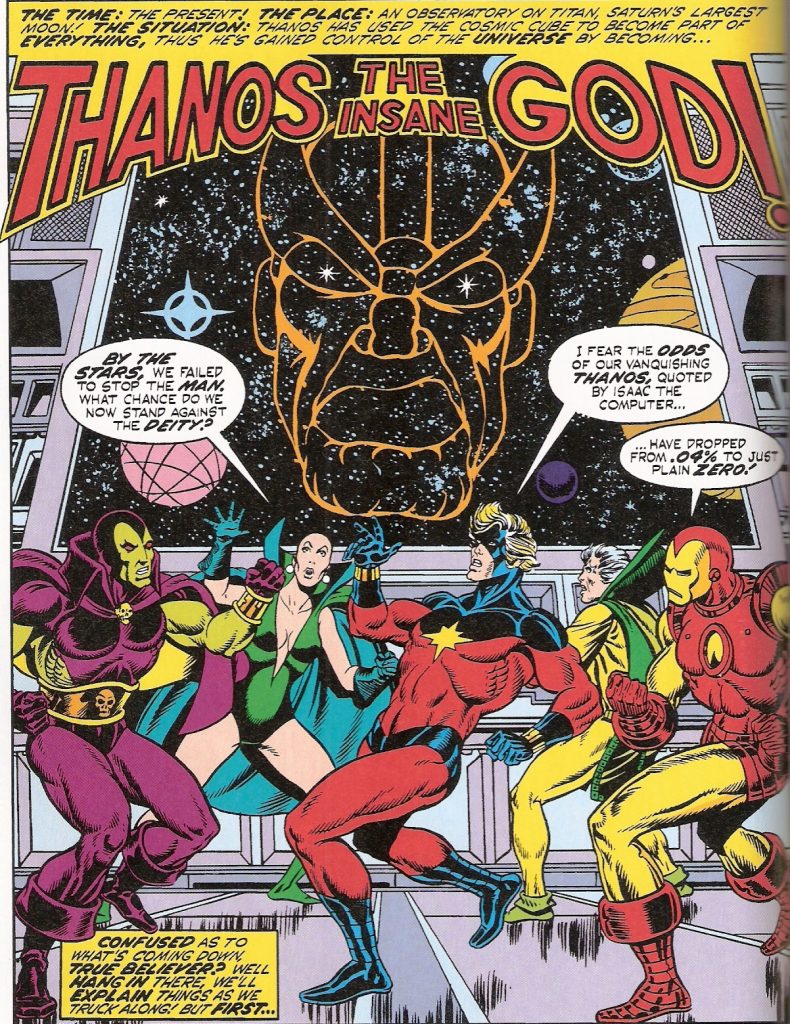
(I’m guessing that the ability to strike that pose without falling on his butt is one of Mar-Vell’s many cosmic powers.)

Meanwhile, over at DC, Jack Kirby, who by this point had left Marvel and abandoned his partnership with Stan Lee, was developing some CM-inspired characters of his own. In 1971, he introduced the “Forever People,” five teenagers who, when they joined together and pronounced the word “TAARU” (which to the best of my knowledge was never established as being an acronym for anything), could summon – and be temporarily replaced by – the superhero Infinity Man.
Three years later, in, 1974, Kirby also introduced OMAC (this one was definitely an acronym, for “One Man Army Corps”), a futuristic amalgamation of CM with Kirby’s own co-creations, Captain America and the Mighty Thor: a timid loser named Buddy Blank is involuntarily transformed, by a bolt from the sky (originating with a sentient satellite in orbit) into a super-soldier with a distinct personality, discontinuous with Buddy’s.
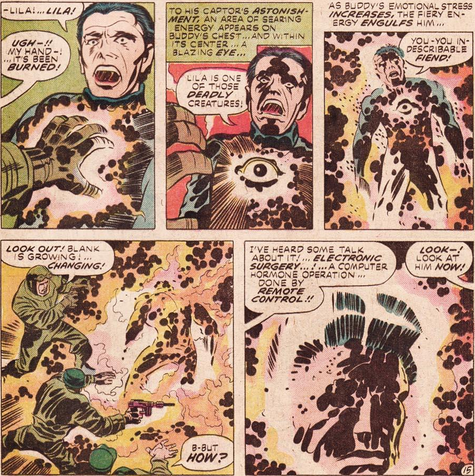
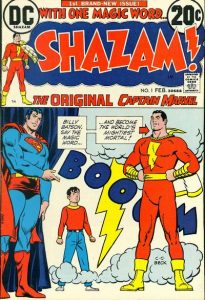

By this time DC had acquired from Fawcett the rights to the original CM character. While they were allowed to use his name, they couldn’t use it in the title of a magazine, as that right remained with Marvel; and so CM was revived, in 1973, in a DC comic titled Shazam! (my first DC comic, as noted above).
The Shazam! title, with a combination of new stories and reprinted classics, introduced a new generation of readers to the Fawcett version of CM. The CM title tended to be lighter and more kid-oriented in tone than most of DC’s other fare, which in turn tended – with some exceptions – to be likewise lighter and more kid-oriented than the work coming out of Marvel; it looks like that difference will continue in the upcoming Shazam! and Captain Marvel movies. (Initially Shazam! used “The ORIGINAL Captain Marvel” as a subtitle, to contrast their hero with their competitor’s Mar-Vell; but a legal challenge from Marvel forced DC to switch the subtitle to “The World’s Mightiest Mortal,” a phrase that Fawcett’s CM comics had used since the 1940s. This is one of many cases in which IP law forbids mere accurate description.) A year later saw the character adapted for a (fairly dreadful) live-action tv series.
In 1977, DC would also revive the previously one-off Black Adam, who over the next two decades would first displace Dr. Sivana as CM’s chief antagonist, and then transition to more of a psychologically tormented antihero modeled on Marvel’s Sub-Mariner. (Dwayne Johnson is expected to play Black Adam in a sequel to the upcoming Shazam! movie.)
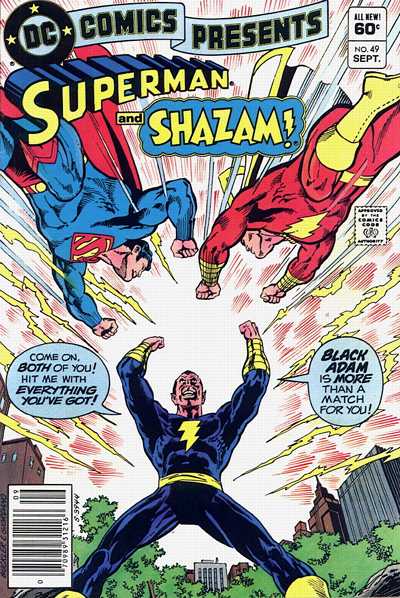
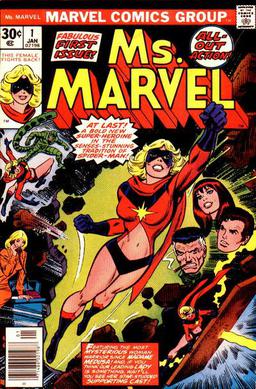
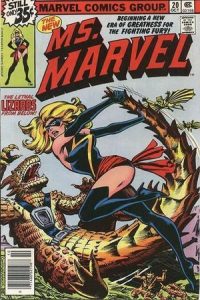
Also in 1977, back at Marvel, Air Force officer Carol Danvers, originally a member of Mar-Vell’s supporting cast, underwent an explosion that caused her to meld temporarily with Mar-Vell, leaving her with similar powers and a similar (but of course more revealing, because comics) costume; this was the origin of “Ms. Marvel” (first of her name). Danvers was initially unaware of her other identity, switching into it involuntarily and having amnesia about it afterward, thus making another case where hero and secret identity were not quite psychologically continuous. (After a few issues, Danvers successfully integrated her psyche and acquired a new costume, this one featuring a lightning bolt, though one rather different from CM’s original.)
Was the name “Carol Danvers” a deliberate reference to “Kara Danvers,” the secret identity of DC’s Supergirl? Possibly; but the Carol Danvers character was around for a decade before getting superpowers. Moreover, during this period Supergirl used “Kara” only as her Kryptonian name, with her human name being “Linda Danvers.” (The comic-book Supergirl didn’t start putting the “Kara” and “Danvers” together as one name until 2016, a year after the tv series had done it first.) So it would have been a pretty tenuous parallel at the time.
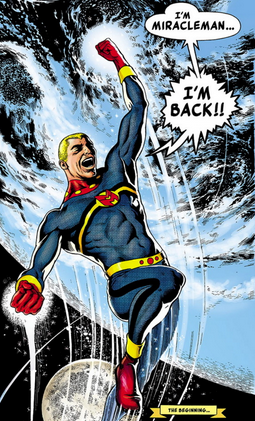
In 1982, back on the other side of the Atlantic, the character of Marvelman was resurrected by Alan Moore in the British comic magazine Warrior. Anticipating by four years his iconic series Watchmen, Moore gave the revived series a dark and deconstructive turn, with an amnesiac Marvelman, a murdered Young Marvelman, and a psychotic, mass-murdering Kid Marvelman. In response to legal threats (IP again!) from Marvel Comics, Marvelman’s name was changed to “Miracleman.” A change of publishers to Eclipse Comics in the u.s. brought in Neil Gaiman (of Sandman fame) as a replacement for Moore.
When Eclipse went out of business, Spawn creator Todd McFarlane bought up all of its associated IP rights, which he took to include Miracleman; Gaiman disagreed, claiming ownership in his own Miracleman contributions, and a lengthy and complicated legal battle ensued, during which any new Miracleman stories were suspended. The case was eventually decided in Gaiman’s favour – until it transpired that the IP rights actually still resided with Mick Anglo. In 2009, Marvel Comics took itself to have cut through this Gordian knot by purchasing the IP rights directly from Anglo, but their release of new Miracleman material has been periodically interrupted by renewed legal difficulties; the series is expected, however, to return once again later this year, with Gaiman attached. (Here, as elsewhere, I’m streamlining a much more tangled tale.)
In the meantime, in the wake of Mar-Vell’s death in 1982, the CM moniker had been temporarily bestowed on a shifting series of Marvel characters in order to protect the trademark; these included Monica Rambeau (a human with no particular connection to Mar-Vell), Genis-Vell and Phyla-Vell (Mar-Vell’s lab-grown children), Noh-Varr (a confused Kree), and Khn’nr (an even more confused Skrull). (There were a few different Ms. Marvels for a while as well, during the period when Danvers herself was experimenting with such names as Binary and Warbird.)

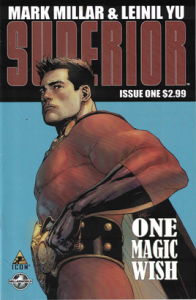
In 2010, Marvel debuted a comic book series titled Superior, written by Mark Millar (of Kick-Ass fame), which is essentially another dark knockoff of the original CM, with the tag line “One Magic Wish” instead of “One Magic Word”: a magical being gives wheelchair-bound twelve-year-old Simon Pooni the power to transform into an adult superhero, but the motives behind this gift turn out to be less than benign. So far as I’m aware, nobody has sued anybody over this iteration of the CM concept (as yet!).

Back at DC, a decision was being made to change CM’s name. Given that DC was not allowed to use the phrase “Captain Marvel” in the title of any magazine, movie, or tv show, having to rely on the word “Shazam!” instead, the inevitable result was that many titles necessarily gave the impression that “Shazam” was the character’s name – as in the 1978 crossover comic, which had to be titled Superman vs. Shazam! rather than Superman vs. Captain Marvel. So in 2011, DC officially changed CM’s name to Shazam, on the grounds that that’s what casual readers and viewers tended to think it was already.
This change did have the awkward consequence of either a) leaving the hero unable to tell anyone his name without triggering his transformation, or else b) having the magic word serve to summon the magic lightning only sometimes. (I believe they tried out both options.) Admittedly, such a situation had already occurred during the Fawcett years, as Captain Marvel Jr.’s word of transformation was “Captain Marvel” rather than “Shazam.” (Similarly, Young Marvelman and Kid Marvelman transformed by saying “Marvelman” rather than “Kimota.”) One might think a better solution would be to revert to CM’s original handle, Captain Thunder, which as far as I know is no longer encumbered (DC has used it a number of times for alternative versions of CM); but what do I know? Around the same time, CM’s longtime foe Dr. Sivana was rewritten as a sorcerer rather than a scientist (perhaps because as a bald technological genius antagonist he was too similar to Lex Luthor). The upcoming movie seems to be taking this route with Sivana as well.
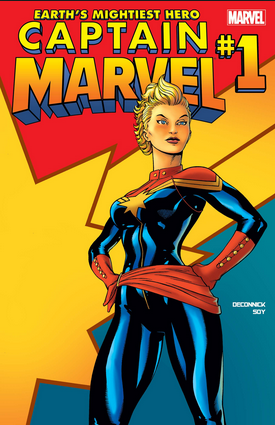
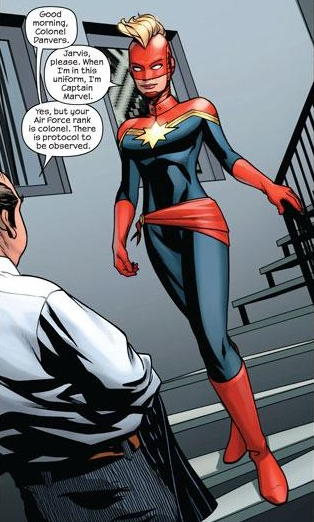
Over at Marvel, the most popular of Mar-Vell’s successors, Carol Danvers, was pretty much the only one who’d never used the name “Captain Marvel” in the IP-securing rotation; so in 2012 the natural move was made and Danvers became the new CM (most likely for good), passing the “Ms. Marvel” title to a new hero, Kamala Khan. Danvers’ new CM costume borrowed the Mar-Vell starburst from her first costume and the sash from her later costume, as well as an optional helmet reminiscent of Mar-Vell’s original Kree uniform. Her new tagline, “Earth’s Mightiest Hero,” was an amalgamation of the Fawcett/DC CM’s traditional sobriquet “World’s Mightiest Mortal” and the traditional tag of Marvel’s Avengers (of whom Danvers has periodically been a member), “Earth’s Mightiest Heroes.”
And that’s how it came about that the original Ms. Marvel is about to debut on the big screen as Captain Marvel, while the original Captain Marvel is about to return (not debut; remember the 1941 serial) to the big screen as Shazam.
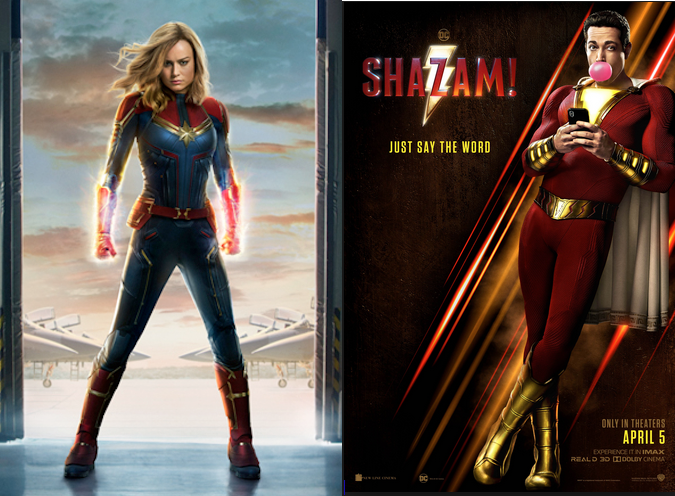
I wonder if Him/Adam Warlock is also somehow related, given his original appearance/outfit included a lightning bolt and so on.
Most incarnations of the Flash, going back to the beginning, have featured costumes with a lightning bolt on a red background also. Since the original Flash and CM debuted simultaneously and independently, I didn’t treat that design feature by itself as a definitive link — which is why I didn’t cover Warlock.
I might do a post some day on Warlock (Starlin’s version) and Sandman (Gaiman’s version) as two brooding, doomed heroes whose lineage runs back through Moorcock’s Elric and various Byronic heroes ultimately to Milton’s version of Satan and Shakespeare’s version of Hamlet (and maybe to Kullervo and the like as well).
I also wonder if “Black Adam” and The Magus are somehow related. Don’t you think the lightning bolts on Warlock/Magus and Shazam/CM are identical in design?
BTW, the “Thanos the insane god” page features the same pose essentially duplicated amongst five different characters shown in different angles, and the purpose may be to get the characters low enough in the picture plane to allow for Thanos dominating face on the viewscreen. THey also have mostly the same facial expressions, even in Thanos’ case.
I would say, make the characters fit drawing them at a smaller scale, and with different, more naturalistic poses. This is why you hire George Perez to draw these types of comics, because you don’t end up with these issues at the end.
Certainly Black Adam and the Magus both have the “evil counterpart of the main hero” thing going on (though the Magus represents a much more interesting threat). But doesn’t that just mean they have lightning bolts because the corresponding heroes have lightning bolts? (Ditto the Reverse-Flash, whose lightning bolt resembles the Flash’s.)
Re the Starlin page: Starlin was essentially a 90s comics artist two decades early, with both the virtues and the vices that implies. He tended to produce over-muscled heroes in contorted poses; on the other hand, his art was often astonishingly beautiful for 1970s comics.
And he did have a recurring fondness for the almost-falling-backwards pose. Was he doing it to save space? Maybe; but my guess is that he thought it looked cool and dynamic. I mean, he kept doing it:
https://i.pinimg.com/originals/7a/1e/89/7a1e89ad5d6d0bf01b7c60c81c3992cc.jpg
https://i.pinimg.com/originals/3e/b5/ef/3eb5ef21c5755a7ad6e40a5d1d8976e3.jpg
https://dyn1.heritagestatic.com/lf?set=path%5B1%2F7%2F1%2F7%2F7%2F17177422%5D%2Csizedata%5B850x600%5D&call=url%5Bfile%3Aproduct.chain%5D
Plus, even if it doesn’t make much sense literally, I think it works metaphorically, to convey “the heroes are thrown off balance by Thanos’s ascension.”
In related news, here’s Starlin tripping on some serious acid:
https://pixel.nymag.com/imgs/daily/vulture/2018/04/10/starlin/10-jim-starlin-captain-marvel.nocrop.w710.h2147483647.2x.jpg
Great overview. As a long time fan, I’m hoping the Shazam movie is at least decent, but I’m really not expecting too much.
Great article. But you left out Captain Marbles.
Captain Marbles appeared in the 8-page story “Superduperman!” in Mad issue 4, cover dated April-May 1953, written by Harvey Kurtzman, drawn by Wally Wood, and published by William M. Gaines’ EC Comics.
Billy Spafon, boy reporter, says the magic word Shazoom (standing for Strength; Health; Aptitude; Zeal; Ox, power of; Ox, power of another; Money!), and becomes Captain Marbles, with a dollar sign on the front of his costume, which seems rather Randian.
The conflict between Superduperman and Captain Marbles parodied the legal fight between National Comics and Fawcett Publications.
“Superduperman!” was a big success for Mad, which had not been selling well, and the first time Mad parodied specific, identifiable characters in popular culture. National Comics threatened to sue EC Comics for infringement, but EC disregarded the threat, and National did not follow through. See https://en.wikipedia.org/wiki/Superduperman
“Superduperman!” is online here: http://whatwoodwallydo.blogspot.com/2009/02/superduperman.html
Oh, I’m aware I left out lots of things. For example, long before Marvelman officially became Miracleman, Alan Moore had already created a parody of Marvelman likewise named Miracleman. And Mick Anglo had created an alternative version called Captain Miracle. To tell the full story of all these iterations would require a book, not a blog post!
Incidentally, there’s a post on CBR today about the different ways DC has dealt with a character’s magic word also being his name or part of his name.
And here’s a new post from CBR covering largely the same ground I did in this post; but it includes some info I didn’t, and I included some info it didn’t, so neither one is a substitute for the other.
And now a post from CBR noticing a Genis-Vell tie-in toy (wearing something like Mar-Vell’s original costume), which might imply that Genis-Vell is in the film.